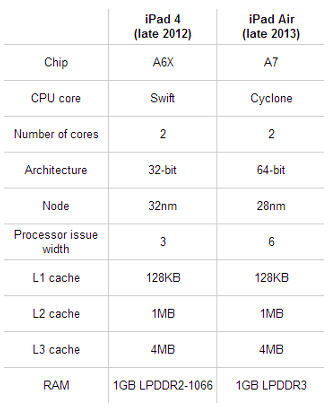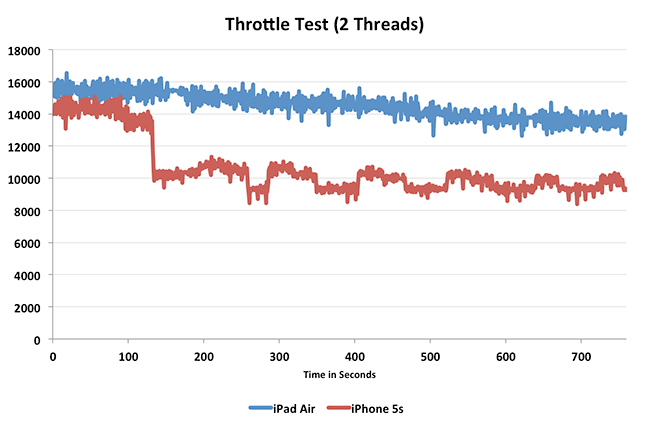V-am spus astazi ca in iPad Air regasim acelasi chip A7 precum in iPhone 5S, iar in imaginea de mai sus vedeti cum difera el fata de chip-ul A6X implementat in iPad 4. Produs folosind un proces de fabricatie de 28 nm, noul chip are performante mult mai bune si consuma mai putina energie decat chip-ul lansat anul trecut de catre Apple, insa pastreaza acelasi cache al procesorului, desi utilizeaza RAM DDR 3 mult mai rapid. Pana in prezent s-a demonstrat ca acest chip este cel mai rapid de pe piata, insa performantele sale nu sunt constante in cazul utilizarii indelungate la “frecventa maxima”.
Testate folosind aplicatii care forteaza procesoarele sa lucreze la viteza maxima, s-a descoperit ca iPhone 5S isi reduce viteza de procesare de la 1.3 GHz la 900 MHz dupa 2 minute de utilizare intensa, in timp ce tableta iPad Air isi reduce frecventa de la 1.4 GHz la 1.2 GHz, insa intr-un ritm mai lent. Practic performantele iPhone 5S se vor reduce simtitor dupa fortarea procesoarelor sa ruleze la frecventa maxima pentru 2 minute, in timp ce in cazul tabletei iPad nu se va intampla acelasi lucru. Sistemul implementat de catre Apple a fost gandit in ideea de a nu folosi toata energia baterie dintr-odata in aplicatii care consuma multe resurse, astfel ca frecventa procesorului este redusa pana la o valoare care sa permita doar rularea in conditii optime a aplicatiilor.
You can see the 5s throttles back its CPU frequency to about 1GHz after the 2 minute mark. The crazy thing is that until that point the 5s manages to run at full frequency without so much as a hiccup for two full minutes, running an incredibly power hungry task. The iPad Air by comparison shows much more controlled behavior. Early on in the test we see a 7.7% performance advantage, which lines up perfectly with the iPad Air’s 7.7% CPU frequency advantage. By the end of the test the iPhone 5s has throttled to 900MHz, while the iPad Air drops to around 1.2GHz.
Desi nu se stie daca acelasi lucru se intampla si in cazul procesorului grafic, exista sanse ca Apple sa aplice un sistem similar, in special pentru jocuri, acestea consumand extrem de multe resurse. In concluzie, iPhone 5S are performante bune, insa doar timp de doua minute, dupa care ruleaza la o frecventa similara cu cea a iPhone 4S. Chiar daca frecventa este similara si vorbim tot despre doua nuclee pentru procesor, diferenta dintre arhitectura procesoarelor ofera un mare plus de performanta pentru iPhone 5S.























